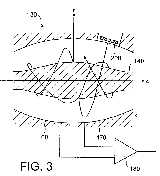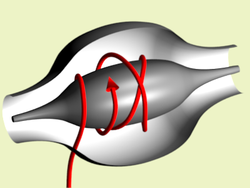
Orbitrap
Encyclopedia
An orbitrap is a type of mass spectrometer invented by Alexander Makarov
. It consists of an outer barrel-like electrode and a coaxial inner spindle-like electrode that form an electrostatic field with quadro-logarithmic potential distribution.
s. Thus, ions cycle around the central electrode in rings. In addition, the ions also move back and forth along the axis of the central electrode. Therefore, ions of a specific mass-to-charge ratio
move in rings which oscillate along the central spindle. The frequency of these harmonic oscillations is independent of the ion velocity and is inversely proportional to the square root of the mass-to-charge ratio (m/z or m/q). By sensing the ion oscillation in a manner similar to that used in FTICR-MS
, the trap can be used as a mass analyzer. Orbitraps have a high mass accuracy (1–2 ppm), a high resolving power (up to 200,000) and a high dynamic range
(around 5000).
 Like FTICR-MS
Like FTICR-MS
the orbitrap resolving power is proportional to the number of harmonic oscillations of the ions; as a result, the resolving power is inversely proportional to the square root of m/z and proportional to acquisition time. Scigelova and Makarov show the resolving power to be 7500 per 0.1 second transient at m/z 400. A transient being the duration that the time domain signal is acquired for. The resolving power decreases further as the m/z value increases so that at 4 times the m/z value (1600) the resolving power has halved to 3750 per 0.1 second. Approximately 0.1 seconds per transient is required for data processing, thus a 0.1 second transient has a cycle time of 0.2 seconds. These effects in combination result in a resolving power of 7500 at m/z 400 and 3750 at m/z 1600 when the orbitrap is operating at 5 acquisitions per second.
A linear ion trap can be used as a front end for the orbitrap; this combination has been marketed by Thermo Fisher Scientific
as the LTQ Orbitrap.
Alexander Alexeyevich Makarov
Alexander Alexeyevich Makarov is a Russian physicist who led the team that developed the Orbitrap, a type of mass spectrometer, and received the 2008 American Society for Mass Spectrometry Distinguished Contribution in Mass Spectrometry Award for this development.- Early life and education :* 1989...
. It consists of an outer barrel-like electrode and a coaxial inner spindle-like electrode that form an electrostatic field with quadro-logarithmic potential distribution.
Principle of operation
In an orbitrap, ions are injected tangentially into the electric field between the electrodes and trapped because their electrostatic attraction to the inner electrode is balanced by centrifugal forceCentrifugal force
Centrifugal force can generally be any force directed outward relative to some origin. More particularly, in classical mechanics, the centrifugal force is an outward force which arises when describing the motion of objects in a rotating reference frame...
s. Thus, ions cycle around the central electrode in rings. In addition, the ions also move back and forth along the axis of the central electrode. Therefore, ions of a specific mass-to-charge ratio
Mass-to-charge ratio
The mass-to-charge ratio ratio is a physical quantity that is widely used in the electrodynamics of charged particles, e.g. in electron optics and ion optics. It appears in the scientific fields of lithography, electron microscopy, cathode ray tubes, accelerator physics, nuclear physics, Auger...
move in rings which oscillate along the central spindle. The frequency of these harmonic oscillations is independent of the ion velocity and is inversely proportional to the square root of the mass-to-charge ratio (m/z or m/q). By sensing the ion oscillation in a manner similar to that used in FTICR-MS
Fourier transform ion cyclotron resonance
Fourier transform ion cyclotron resonance mass spectrometry, also known as Fourier transform mass spectrometry, is a type of mass analyzer for determining the mass-to-charge ratio of ions based on the cyclotron frequency of the ions in a fixed magnetic field...
, the trap can be used as a mass analyzer. Orbitraps have a high mass accuracy (1–2 ppm), a high resolving power (up to 200,000) and a high dynamic range
Dynamic range
Dynamic range, abbreviated DR or DNR, is the ratio between the largest and smallest possible values of a changeable quantity, such as in sound and light. It is measured as a ratio, or as a base-10 or base-2 logarithmic value.-Dynamic range and human perception:The human senses of sight and...
(around 5000).

Fourier transform ion cyclotron resonance
Fourier transform ion cyclotron resonance mass spectrometry, also known as Fourier transform mass spectrometry, is a type of mass analyzer for determining the mass-to-charge ratio of ions based on the cyclotron frequency of the ions in a fixed magnetic field...
the orbitrap resolving power is proportional to the number of harmonic oscillations of the ions; as a result, the resolving power is inversely proportional to the square root of m/z and proportional to acquisition time. Scigelova and Makarov show the resolving power to be 7500 per 0.1 second transient at m/z 400. A transient being the duration that the time domain signal is acquired for. The resolving power decreases further as the m/z value increases so that at 4 times the m/z value (1600) the resolving power has halved to 3750 per 0.1 second. Approximately 0.1 seconds per transient is required for data processing, thus a 0.1 second transient has a cycle time of 0.2 seconds. These effects in combination result in a resolving power of 7500 at m/z 400 and 3750 at m/z 1600 when the orbitrap is operating at 5 acquisitions per second.
A linear ion trap can be used as a front end for the orbitrap; this combination has been marketed by Thermo Fisher Scientific
Thermo Fisher Scientific
Thermo Fisher Scientific is a large life sciences supply company that was created in 2006 by the merger of Thermo Electron and Fisher Scientific.-Predecessors and merger:...
as the LTQ Orbitrap.

